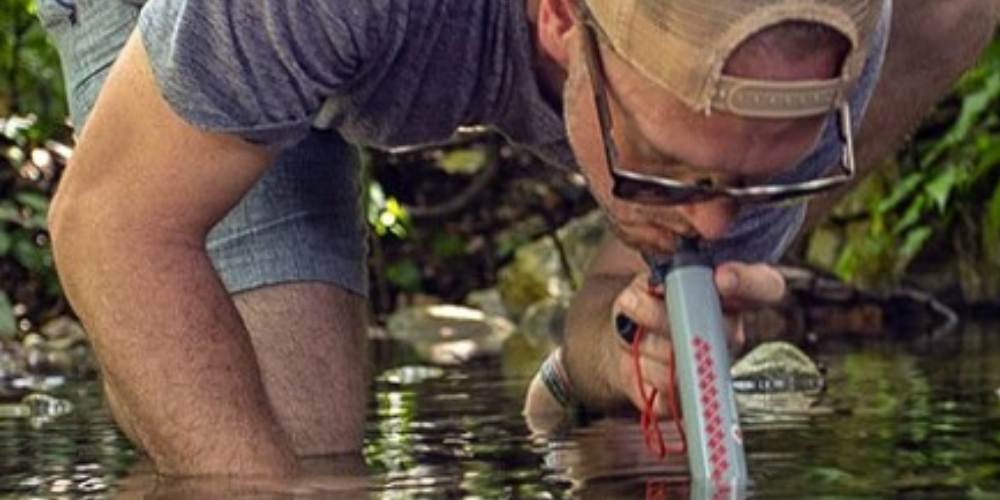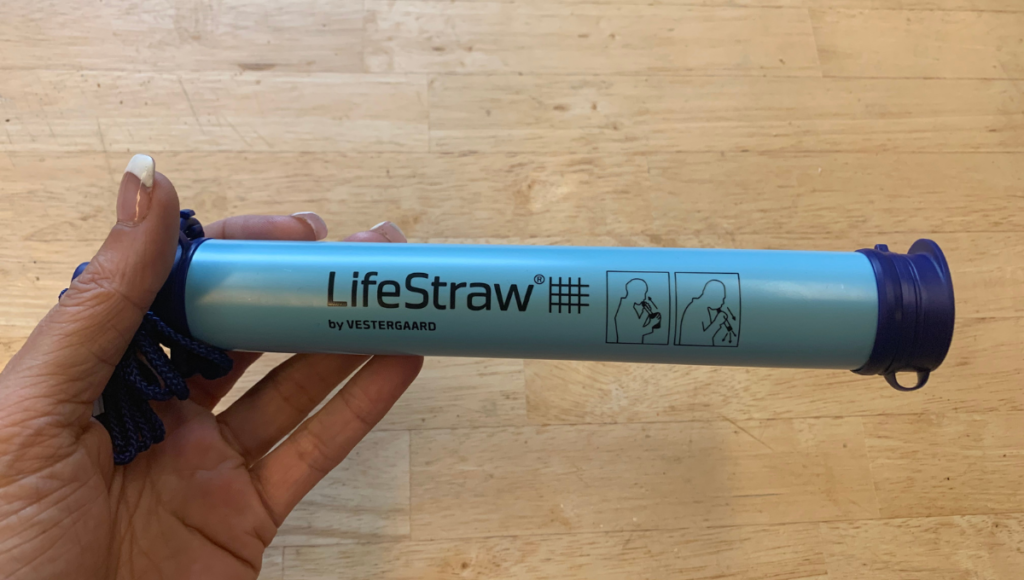Last Updated on May 3, 2023 by
What if you were in a survival situation and you had no clean water and only a personal survival straw. Would you feel safe and have peace of mind that you could make it without having the convenience of bottled water?
Do Survival Straws Work?
Survival straws work extremely well at filtering water because they are designed to remove 99.9% of bacteria, parasite (Giardia, Cryptosporidium), microplastics, and turbidity. And depending on the pore size of the filter you choose, they can even filter out most viruses.
Those straws with a smaller pore filter (.02 microns) can also filter out viruses as opposed to its larger counterpart of .2 micron pore size. Some of these straws will use the process of reverse osmosis when cleaning water from various harmful stuff.
With that said, there is so much more to explore about survival life straws. Let’s take a look at the exact way how these survival gadgets can prove helpful in different situations.
How Survival Straws Work

Survival straws consist of BPA free plastic and a filter inside. The microfiber filter has pores that are smaller than 0.2 microns in size. Dust and other contaminants in water are usually bigger than the pores of the filter.
So when you put the survival straw in a water source and suck the water through the straw, the harmful objects can’t enter the pores due to their bigger size.
However, some survival straws may not work if the pore size is bigger than the objects and they also might not work against heavy metals such as lead.
For example, The original LifeStraw does not filter viruses, chemicals, saltwater, and heavy metals. This has been changed slightly now so that the LifeStraw in particular now removes a minimum of 99.999% of waterborne protozoan parasites including Giardia and Cryptosporidium.
Reusability Of Survival Straws
Most survival straws are reusable because they consist of microfiber filter. The main application of the filter is to remove the pollutants from the water. Since there aren’t any chemicals involved, it means you can use them as many times as you need to, up to the recommended number of uses by the manufacturer.
However, I wouldn’t recommend using the same straw for a lifetime. It is because the microfiber filter can get dirty, and as a result, it will lose its effectiveness with time. To get the most out of your Lifestraw personal water filter, the manufacturer recommends using it for 1000 liters at max before you need a new one.
How Long Do Survival Straws Last?
Survival straws have been safely known to last three to five years. Survival straws are excellent tools to trust, especially when you are out in the wilderness because most of these gadgets have plastic or metal structure that makes them quite durable to withstand any kind of environment.
Apart from that, it doesn’t have any moving parts, which makes them less vulnerable. However, you should keep the filter’s effectiveness in mind. A survival straw may withstand the harsh challenges of the environment, but the filter will lose its effectiveness with time.
Survival Straw Safety
Survival straws are extremely safe for use as the filters used to filter water typically are all EPA approved. Many of them have been through rigorous testing and scrutiny by the manufacturer as well. Most survival straws have ultra-thin filters that make them entirely trustworthy for handling different situations.
With that said, you need to get a water filter that is safe for your area because some of them may not filter viruses and other heavy metals and salts in the water. For example, if you live in the United States, the standard water filters that people use for hiking and backpacking work just fine against water-born bacteria, protozoa and mud.
It’s all about pore size of the filters inside the actual water filter device. Most standard water filters for camping will run anywhere between .1 – .2 microns in pore size. Just enough to filter out anything that will make sure you sick.
Survival Water Filter Amounts
The amount of water filter is another problem that you need to plan for. Some personal water filters aren’t capable enough to withstand more than 1000 liters.
However, a good survival straw can give you much more than that. Survival straws like the Lifestraw are capable of providing water filtration for up to 4000 liters (1,000 gallons) which is approximately 264 gallons per year over an approximate 4 year period.
Related Questions and Answers

How Do You Clean A Lifestraw?
Cleaning not just the Lifestraw but any survival straw is quite important because if you don’t clean it properly the mud particle may stick inside and clog the pores. But you need to carry a proper procedure to clean your Lifestraw. First of all blow into the straw to remove the water from inside.
Once you are sure that there isn’t any water inside, next you need to take a glass of clean water. I would recommend boil some water if you can and then suck it through the straw. This will clean the pores if there is any pollutants stuck inside the water will remove them. Cleaning the Lifestraw isn’t that hard once you get used to the process.
You should keep the caps on always when you aren’t using the straw to protect the filter from environmental challenges.
Can You Use A Lifestraw in Saltwater?
No. You can’t use the Lifestraw to filter saltwater. Ideally, the Lifestraw is designed to filter all kinds of fresh water. The only downside is that the Lifestraw doesn’t block salt from the water during the filtration process.
The only way to remove salt from water is with the help of a special kind of filter. It uses the reverse osmosis process that blocks not only salt but also viruses and other heavy metals such as lead.
How Do You Know When To Replace A Lifestraw?
No matter what brand of personal water filter you buy, the manufacturer will usually tell you in the user manual when to replace the water filter.
As far as I know, the Lifestraw will last up to about 200 uses according to the manufacturer website. They also mention that after 1000 liters it’s time to replace it.
If you don’t replace your Lifestraw you will notice drinking water though it gets harder and harder. It is because with regular use the mud particles clogs the pores of the filters. Once you feel that your straw requires a bit of a struggle to pull water you need to change it.
Does LifeStraw have an expiration date?
The best thing about the LifeStraw is that it doesn’t have an expiration date, although originally the manufacturer had a 3-5 year shelf-life on the package but then later removed it. Since the device is based on a simple mechanism that draws water from the source it doesn’t necessarily expire, but it will definitely lose its effectiveness with time and regular usage.
From my personal experience, I would recommend replacing the straw once you feel it a bit difficult to draw water to the mouth piece with the device.
Does The Lifestraw Kill Viruses?
The basic purpose of the Lifestraw is to provide you clean drinkable water. It doesn’t contain a small enough filtration system to kill viruses. So the answer to this question is no, the Lifestraw isn’t designed to kill viruses.
With that said, it can block many kinds of organisms such as bacteria, protozoa etc. In addition to this the Lifestraw also successfully blocks mud particles and other harmful stuff. So the Lifestraw may not be as effective against viruses but it is helpful against other threats.
Can LifeStraw Filter Chlorine?
The Lifestraw isn’t as effective at filtering out chlorine, but it will definitely help. The Lifestraw is made with membrane microfilters. Because of this, LifeStraw’s membrane microfilters are capable of removing 99.999999% (log 8) of bacteria (including E. coli), 99.999% (log 5) of parasites (Giardia, Cryptosporidium, etc.), and 99.999% (log 5) of microplastics.
It wouldn’t hurt to use the Lifestraw if pool water, for example, was your only source for water but just remember that chlorine is considered a chemical and these Lifestraws are better used for bacteria, viruses, and protozoa then lead or chemicals.
Can You Filter Your Own Urine With A Lifestraw?
In some survival programs, you may have seen survival experts drinking their own urine. Gross right?! I guess you could do it if you had no water left, but the Lifestraw is only going to help for a short amount of time because as you get more dehydrated, you urine gets more concentrated and can actually become toxic.
It contains a higher amount of urea and salt that aren’t good for health, so if you’re going to try and drink your urine through a Lifestraw, do it early!
Final Thoughts
Survival straws are pretty amazing gadgets for survival situations. They are pretty lightweight and easy to use.
So to answer the question if Lifestraws work or not…..the answer is absolutely! (depending on the water you are trying to filter of course).
Yes It works against basic contaminants such as waterborn bacteria, protozoa, algae and mud particles. It may also block some metals and other dissolved elements. However, if you expect your survival straw to protect you from viruses and heavy metals then you will need a special kind of straw that uses the reverse osmosis.
If there’s anything you would like to add to this post or any insight you have on this subject, please feel free to comment below.
